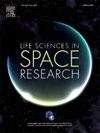Activation of the visual system by space radiation: A novel study on Ca2+ signalling in ex-vivo rabbit eyes exposed to visible light, X-rays and high-energy protons
IF 2.8
3区 生物学
Q2 ASTRONOMY & ASTROPHYSICS
引用次数: 0
Abstract
Space radiation interactions with the visual system have been the subject of many investigations, starting from astronauts reporting the perception of light flashes (visual illusions in absence of light stimuli). These perceptions have been attributed to single-ion hits, able to induce an electrophysiological response in the eye. Searching for a more general mechanism of radiation interaction with cortical neuronal networks and with sensory systems, a valuable hypothesis is that of the perturbation to calcium (Ca2+) homeostasis.
We here report results on radiation-induced perturbation of Ca2+ signalling obtained with an ex-vivo whole rabbit eye model. Surgically enucleated eyes (from animals intended for human consumption) were kept in viable conditions and exposed to visible light (varying the duration of the exposure), to kilovoltage X-rays (reference radiation, dose range 10–200 mGy) and to 230 MeV protons (representative of the main component of space radiation, dose range 10–20 mGy). After extraction of the vitreous humor, sample stability and homogeneity in the animal population and organ conditions were verified by measuring the concentration of biogenic polyamines, while eye integrity was tested by measuring the lactate dehydrogenase (LDH) enzymatic activity. The activation of the visual response is attributed to a change in the Ca2+ concentration (expressed μg calcium/μg amines) comparing, for each animal, the left eye used as a control and the right eye exposed to light or ionizing radiation. The vitrectomy was conducted immediately after the exposure.
A significant increase in Ca2+ concentration was measured after white light exposure with a duration longer than 1 min, with a saturation to a ∼150 % relative change for exposure durations of 3 and 5 min. The model was therefore validated for the visual system activation by light, but no increase in Ca2+ concentration was found for ionizing radiation exposures in the investigated dose ranges. Only at the highest X-ray dose of 200 mGy, eyes were severely damaged, as demonstrated by the drastic increase in LDH activity. Based on these findings, the limitations of the study are critically discussed, and improvement strategies are suggested, also considering the rapid kinetics of the perturbation that might hinder the measurement of small ionizing radiation-induced transient Ca2+ changes.
空间辐射对视觉系统的激活:暴露于可见光、x射线和高能质子的离体兔子眼睛中Ca2+信号的新研究
空间辐射与视觉系统的相互作用一直是许多研究的主题,从宇航员报告的闪光感知开始(没有光刺激的视觉错觉)。这些感觉归因于单离子撞击,能够在眼睛中引起电生理反应。寻找辐射与皮质神经元网络和感觉系统相互作用的更一般的机制,一个有价值的假设是对钙(Ca2+)稳态的扰动。我们在这里报告了用离体全兔眼模型获得的辐射诱导的Ca2+信号扰动的结果。手术切除的眼睛(来自供人类食用的动物)保存在可存活的条件下,并暴露于可见光(不同暴露时间)、千伏x射线(参考辐射,剂量范围10-200毫戈瑞)和230兆电子伏特质子(代表空间辐射的主要成分,剂量范围10-20毫戈瑞)。玻璃体提取后,通过测定生物源性多胺的浓度来验证样品在动物种群和器官条件下的稳定性和均匀性,同时通过测定乳酸脱氢酶(LDH)酶活性来检测眼睛的完整性。视觉反应的激活归因于Ca2+浓度的变化(表达为μg钙/μg胺),比较每只动物的左眼作为对照和暴露于光或电离辐射的右眼。暴露后立即进行了玻璃体切除术。在白光照射持续时间超过1分钟后,测量到Ca2+浓度显著增加,在照射持续时间为3和5分钟时,饱和度相对变化为~ 150%。因此,该模型被光验证了视觉系统的激活,但在所研究的剂量范围内,未发现电离辐射照射Ca2+浓度的增加。只有在最高x射线剂量为200 mGy时,眼睛才受到严重损害,LDH活性急剧增加。基于这些发现,本文对研究的局限性进行了批判性讨论,并提出了改进策略,同时考虑到扰动的快速动力学可能会阻碍小电离辐射诱导的瞬态Ca2+变化的测量。
本文章由计算机程序翻译,如有差异,请以英文原文为准。
求助全文
约1分钟内获得全文
求助全文
来源期刊

Life Sciences in Space Research
Agricultural and Biological Sciences-Agricultural and Biological Sciences (miscellaneous)
CiteScore
5.30
自引率
8.00%
发文量
69
期刊介绍:
Life Sciences in Space Research publishes high quality original research and review articles in areas previously covered by the Life Sciences section of COSPAR''s other society journal Advances in Space Research.
Life Sciences in Space Research features an editorial team of top scientists in the space radiation field and guarantees a fast turnaround time from submission to editorial decision.
 求助内容:
求助内容: 应助结果提醒方式:
应助结果提醒方式:


